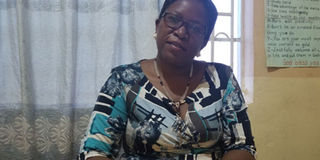An upcountry teaching job turned Namata into a leader to reckon with

Holding yourself to the same classroom code of conduct and standards established in cooperation with your students gives you the opportunity to model the behaviours you expect from them. PHOTO BY Ambrose Musasizi
What you need to know:
Little did she know that joining St. Cecilia would be the beginning of a great career ahead. While there, Namata developed relations with other staff members to ease the adaptation process.
Florence Namata Kawubiri is the head teacher of St Nicholas Primary School, Mannya in Rakai District and has taught for the last 20 years. She believes teaching it is a calling from God and has never regretted joining the profession.
Namata was born on December 5, 1976 at Walukuba Village, Masese Division, Jinja District. She joined Primary One in 1983 at Spire Road Primary School in Jinja District and sat for her PLE in 1990 then later joined PMM Girls’ SS, Jinja for her O-Level in 1991 to 1995. She went on to join Wanyange Teachers’ College from 1996 to 1998 where she acquired a Grade III Certificate.
Humble beginnings
Namata started teaching at Kireka Primary School in 1999 and after two months was convinced by her father to join St Cecilia Boarding Primary School Buyamba in Rakai District.
“I did not have intentions of working up country because I thought most of the great opportunities would be found in Kampala”, she recalls.
Little did she know that joining St. Cecilia would be the beginning of a great career ahead. While there, Namata developed relations with other staff members to ease the adaptation process.
Growing in rank
After five years, Namata upgraded with a diploma in Special Needs Education at Kyambogo University from 2005 to 2008. She further pursued a Bachelor’s degree in Education still at Kyambogo University from 2009 to 2011 and a Master’s degree in Public Administration and Management at Uganda Management Institute in 2017 to 2019.
In 2010, Ms Namata was appointed to head St. Nicholas Mannya Primary School in the same district, an achievement she treasures much. She says her appointment was an indication that God was with her and people appreciated her managerial and teaching skills which she applied at the former school.
Making strides at St. Nicholas Mannya
When she joined St Nicholas Namata, the standard of the school was too low. She, therefore, made it her goal to change the status quo.
“We had the best buildings compared to other schools in the district built by the Cotton-on Foundation but had the worst academic performance,” she says.
Success strategy
The pupils were first taught to be disciplined and then trained in self-confidence and independence.
“They were empowered to the point that they would conduct assemblies in the absence of and without any guidance from teachers,” she remarks.
Namata also introduced an annual ‘professional day’ where people from different professional walks of life such as teachers, engineers, journalists, doctors and plumbers, among others are brought to the school to talk to pupils about life in the given profession. This helps them envision their future.
John Kisira, a teacher at the school says such innovations have aided improvement in the school performance.
“Namata has improved the performance and discipline of the pupils and this has seen even the numbers increase from 364 pupils in 2009 to 855 pupils currently,” Kisira says.
He says Namata makes the teaching profession ‘look good’.
Be a Role Model
Students can be impressionable, and the old adage “do as I say, not as I do” isn’t enough to convince youth to behave a certain way when you and other adults behave differently. Holding yourself to the same classroom code of conduct and standards established in cooperation with your students gives you the opportunity to model the behaviours you expect from them. If you really want to see students behave a certain way in your classroom, it’s important for them to see those behaviours happening at the front of class too.
Reinforce and Reward Positive Behaviour
Parents and teachers know that it is much easier to focus on bad behaviours than the good ones, but it’s important to reinforce positive behaviours when we see them happening. Praising positive behaviours in the classroom is a simple, yet powerful, way to motivate students to be on their best behaviour. Many classrooms rely on physical objects such as stickers or certificates to mark recognition. If you use a similar strategy, be sure to tell the student the specific positive behavior observed, ask the student how it made him or her feel to behave that way, and explain to the student that the sticker or certificate is only there to remind them how good it feels to exhibit positive behaviours.
Source: https://onlineprograms.smumn.edu/



